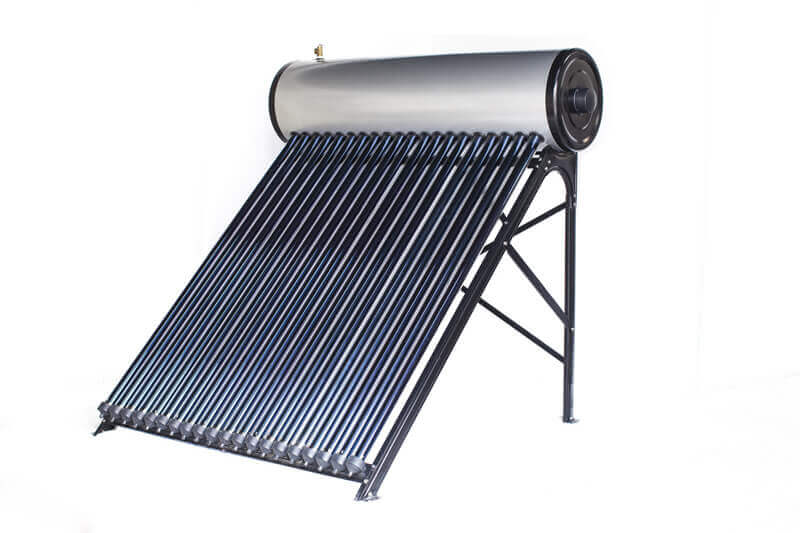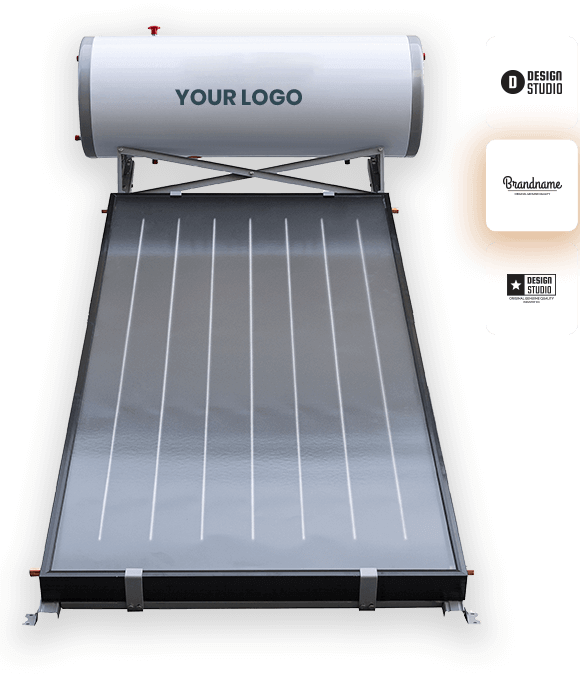Contents
All Glass Tube water heater and VS Flat Plate Solar Water Heaters
Glass tube solar water heaters and flat plate solar water heaters are two popular types of solar water heaters that are widely used around the world. These two types of solar water heaters are designed to use solar energy to heat water, which can then be used for various purposes such as bathing, cooking, and cleaning.
The all-glass tube solar water heater is a type of solar water heater that is made up of a series of glass tubes that are connected to a manifold. The tubes are filled with water and are exposed to the sun, which heats the water inside the tubes. The heated water then rises and is collected in the manifold, where it can be used for various purposes. This type of solar water heater is known for its high efficiency and durability, making it a popular choice for many homeowners and businesses.
On the other hand, the flat plate solar water heater is a type of solar water heater that is made up of a flat plate collector that is placed on the roof of a building. The collector is made up of a series of flat plates that are coated with a special material that absorbs solar energy. The absorbed energy is then transferred to a heat exchanger, which heats the water that flows through it. This type of solar water heater is known for its simplicity and low cost, making it a popular choice for many people who are looking for an affordable and effective way to heat water using solar energy.

All Glass Tube Solar Water Heater
Operation Principle
An All Glass Tube Solar Water Heater is a type of solar water heating system that uses a set of glass tubes to absorb solar energy and heat water. The tubes are made of borosilicate glass and are coated with a selective coating that absorbs solar radiation and minimizes heat loss. The system works by circulating water through the tubes, which heats up as it absorbs the heat from the tubes. The heated water then flows into a storage tank where it can be used for various purposes.
Key Components
The key components of an All Glass Tube Solar Water Heater include the glass tubes, the selective coating, the manifold, the circulation pump, the storage tank, and the control system. The glass tubes are the main component that absorbs solar energy and heats the water. The selective coating is applied to the tubes to improve their efficiency and reduce heat loss. The manifold is used to connect the tubes and allow the water to flow through them. The circulation pump is used to circulate the water through the tubes and into the storage tank. The storage tank is used to store the heated water until it is needed. The control system is used to regulate the temperature and flow of the water.
Benefits
All Glass Tube Solar Water Heaters offer several benefits over other types of solar water heating systems. They are more efficient and have a higher heat transfer rate, which means they can heat water faster and more effectively. They are also more durable and have a longer lifespan than other systems. Additionally, they require less maintenance and are easier to install.
Drawbacks
One potential drawback of All Glass Tube Solar Water Heaters is their cost. They can be more expensive than other types of systems, which may make them less accessible to some consumers. Additionally, they may not be as effective in colder climates or in areas with less sunlight.
Overall, All Glass Tube Solar Water Heaters are a reliable and efficient option for heating water using solar energy.

Flat Plate Solar Water Heater
Operation Principle
A flat plate solar water heater consists of a flat-plate collector, an insulated storage tank, and a circulation pump. The collector is made up of a flat, rectangular box with a transparent cover, and a dark-colored absorber plate. The absorber plate is coated with a special material that absorbs sunlight and converts it into heat. The heat is then transferred to the water that flows through a series of tubes attached to the absorber plate. The heated water is then stored in the insulated tank until it is needed.
Key Components
The key components of a flat plate solar water heater include:
- Flat-plate collector: This is the main component of the system that absorbs sunlight and converts it into heat.
- Insulated storage tank: This is where the heated water is stored until it is needed.
- Circulation pump: This is used to circulate the water between the collector and the storage tank.
- Temperature sensors: These are used to monitor the temperature of the water in the collector and the storage tank.
Benefits
Flat plate solar water heaters have several benefits, including:
- Energy savings: They use renewable energy from the sun, which can save homeowners money on their energy bills.
- Environmentally friendly: They do not produce any greenhouse gas emissions, making them an environmentally friendly option.
- Long lifespan: With proper maintenance, flat plate solar water heaters can last for 20 years or more.
- Low maintenance: They require very little maintenance, making them a convenient option for homeowners.
Drawbacks
Despite their benefits, flat plate solar water heaters have some drawbacks, including:
- High upfront cost: The initial cost of installation can be high, making them less accessible for some homeowners.
- Weather-dependent: They rely on sunlight to heat the water, so they may not be as effective in areas with limited sunlight or during cloudy weather.
- Space requirements: They require a large surface area for installation, which may not be feasible for all homeowners.
Comparison Between Both Types
Efficiency
Both all glass tube solar water heaters and flat plate solar water heaters are efficient in converting solar energy into heat. However, all glass tube solar water heaters are more efficient in colder climates due to their vacuum-sealed tubes that prevent heat loss. Flat plate solar water heaters are more efficient in warmer climates due to their ability to absorb more heat from the sun.
Cost
Flat plate solar water heaters are generally less expensive than all glass tube solar water heaters. They have a simpler design and are easier to manufacture. On the other hand, all glass tube solar water heaters have a more complex design and require more materials, making them more expensive.
Durability
All glass tube solar water heaters are more durable than flat plate solar water heaters. The vacuum-sealed tubes are less likely to break or crack, and they are not affected by extreme temperatures. Flat plate solar water heaters can be damaged by hail or other impacts, and they can also be affected by extreme temperatures.
Maintenance
Both all glass tube solar water heaters and flat plate solar water heaters require regular maintenance to ensure optimal performance. However, all glass tube solar water heaters require less maintenance than flat plate solar water heaters. The vacuum-sealed tubes do not require cleaning, and the system is less prone to scaling and corrosion. Flat plate solar water heaters require more maintenance due to the flat surface that can accumulate dirt and debris, leading to reduced efficiency.
Overall, choosing between all glass tube solar water heaters and flat plate solar water heaters depends on various factors, such as climate, budget, and maintenance requirements.
Conclusion
In conclusion, both all glass tube solar water heaters and flat plate solar water heaters have their own unique advantages and disadvantages.
All glass tube solar water heaters are known for their high efficiency and ability to work well in cold and cloudy weather conditions. They are also more durable and have a longer lifespan than flat plate solar water heaters. However, they are more expensive and require more maintenance.
On the other hand, flat plate solar water heaters are more affordable and easier to install. They also require less maintenance than all glass tube solar water heaters. However, they are less efficient and may not work as well in colder weather conditions.
Ultimately, the choice between an all glass tube solar water heater and a flat plate solar water heater will depend on the specific needs and preferences of the user. It is important to consider factors such as budget, climate, and maintenance requirements before making a decision.
Overall, both types of solar water heaters offer a sustainable and environmentally friendly alternative to traditional water heaters. By harnessing the power of the sun, they can save energy and reduce carbon emissions.
Proper solar water heater installation will ensure that this heating system functions smoothly without any defects.
You should also ensure that you buy the best solar kits from reliable solar water heater manufacturers in China. Combine with proper installation, you will like the results.
https://www.youtube.com/watch?v=VaCy4hvwkKs
Read More
https://pasolar.ncat.org/lesson04.php
https://www.mayutechltd.com/what-you-need-to-know-before-installing-a-solar-water-heater-in-kenya/



